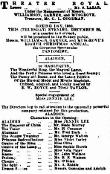The story opens in Egypt, with the scene containing the Sphinx, mummies, Ptolomy and Cheops, sees Ptolomy foretell that the wonderful lamp will be found in Pekin. Abanazer, who very much desires to possess the lamp wants Aladdin to help him in his quest, but this means he must first make amends with the boy's mother, the Widow Twankey. When she finally agrees the pair head off to China. When they arrive there Aladdin becomes smitten with the Princess Badroubladour and proposes marriage, which she at first refuses but later, after Aladdin gives her a bouquet, agrees to. The Vizier is not amused with this situation, however, and forces the boy to flee from the city, where he comes across a cave guarded by the huge Afreet and numerous reptiles. After being given a magic ring, he is instructed to rub it in order to bring forth its genii, who will direct him to the magic lamp. Inside are a mass of jewels, enough to allow him the opportunity to win him the Emperor's consent to marry the Princess. The lamp is protected by all manner of evil looking creatures, but Aladdin manages to seize the lamp and escapes.
Act two sees the story unfold back at Widow Twankey's place. The widow has been concerned at her son's long absence, but is filled with delight when he returns bringing with him all the riches she could imagine. Meanwhile, the Emperor's wealth has been depleted and after hearing about Aladdin's wealth comes calling in the hope that his daughter will provide a means of regaining his former splendour.
The final act of the pantomime (not including the transformation scene and harlequinade), sees Aladdin return to China, where all manner of festivities, acrobatics, singing and dancing are performed. Just when things look like ending happily ever after, however, Abanazer contrives to steal the lamp and this gives him the power to elope with the princess. Aladdin chases him to Africa where he gets both his revenge and the princess. The pantomime culminates with the Emperor receiving a telegram from the Australian premiers announcing Federation.
The transformation scene consisted of four oil paintings illustrating Nibelungenleid, and which show beautiful 'undraped nymphs disporting themselves in the depths of the sea.' Regarding these scenes, the Age critic proposed that 'the most classical chastity of thought is here required from the audience to make the appearance of these ladies excusable... still it is beautiful, and only those who do not go to the theatres will perhaps object' (Age 13 January 1889, p.8)
[Source: Australian Variety Theatre Archive]
 5838592223287906269.jpg
5838592223287906269.jpg
 Aladdin ; Or, Harlequin the Wonderful Ring, the Magical Lamp, and the Pretty Young Princess Who Loved a Great Scamp, the Funny Old Dame and the Latest Edition of the Musical Model and Mystical Magician
single work
pantomime
fantasy
Aladdin ; Or, Harlequin the Wonderful Ring, the Magical Lamp, and the Pretty Young Princess Who Loved a Great Scamp, the Funny Old Dame and the Latest Edition of the Musical Model and Mystical Magician
single work
pantomime
fantasy

